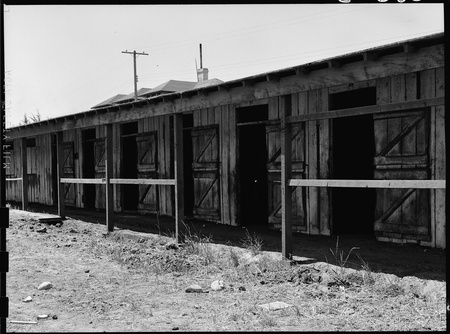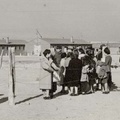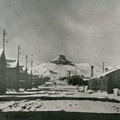The second largest of the so-called “assembly centers” with a peak population of 7,816, Tanforan was built on the site of the Tanforan Racetrack in San Bruno, California, near the present site of the San Francisco International Airport. Its inmate population arrived in late April and early May 1942, and came almost entirely from the San Francisco Bay area and was thus among the most urban of the short-term camps. Essentially the entire inmate population was transferred to the Topaz, Utah, concentration camp in September 1942.
It is now the site of a shopping center and BART station—and just a couple of blocks away from the San Bruno branch of the National Archives, where records on the “assembly centers” are held. Here are ten noteworthy aspects of the Tanforan detention site.
Horse Stall “Apartments”

Tanforan was one of two “assembly centers” that held nearly half of its inmate population in converted horse stalls. Twenty-six horse stables—most of which consisted of fifty stalls—were converted into “apartments” that held the first groups to arrive. Three to six people typically lived in a 10 x 20 stall that had housed one horse.
Each stall was divided into two sections by a swinging half-door; the front section had two small windows, the back section was windowless. In most cases, the stalls had linoleum floors that had been laid over manure stained boards, and the smell of the prior occupants remained behind. As with the newly built barracks, the stalls were initially furnished only with one army cot per person and had a single light bulb for lighting. As with the barracks, walls stopped short of the roof, allowing sound to travel throughout the stable.
Just under half of Tanforan inmates were held in these converted stables, about 3,700 out of a peak population of 7,816. Later arrivals were assigned to the newly built barracks that presaged the barracks found in the War Relocation Authority (WRA) concentration camps.
Not surprisingly, most contemporaneous accounts expressed distress about being forced to live in horse stalls, citing the smell, the lack of privacy, the mud, frequent power outages, leaky roofs, and the utter indignity of the situation.
“When I saw the place for the first time, I was twice as dejected and the vague spark of hope that I had kept in a secret corner of my mind died out. What else could I think as I was put into a musty stable with a fence surrounding the camp?” remembered Kiyoshi Jimmy Kimoto in a 1944 interview with Charles Kikuchi.
“That the stalls should have been called ‘apartments’ was a euphemism so ludicrous it was comical,” wrote Yoshiko Uchida in her camp memoir, Desert Exile.
What is a bit surprising is that some inmates felt that there were advantages to the horse stalls relative to the newly built barracks. In a May 17, 1942 letter to a friend, Fred Hoshiyama wrote that his stable unit was “better than the new barracks cause it doesn’t get too hot on hot days and too cold on cold days. New barracks are new, but no privacy and it gets too cold or too hot.”
A Tanforan Totalizer article cited one group of stables that “were built more substantially than many of the others in Tanforan.” The administration also distributed the limited number of cotton mattresses—versus tic mattresses that had to be stuffed with straw—to those in the stables. But stables or barracks, it was clear that this was concentration camp life.
“Deplorable” Bachelor Housing
For the first few weeks, a large room under the grandstand that had been the area where horse racing fans placed their bets was used as a dormitory for single men. A large room about one hundred yards long, it housed between four hundred and five hundred men in beds separated by one-and-a-half to two feet.
In his diary and letters, Japanese American Evacuation and Resettlement Study (JERS) fieldworker Tamotsu Shibutani called the dormitory “an appalling sight” and and “a hellhouse if I ever saw one.” “The place is filthy, stinky, foul, etc,” he wrote. “I don’t see how anyone could live in a dump like that one and stay sane.” Michio Kunitani referred to it as a “deplorable situation” that saw the men “crowded together in one huge, poorly ventilated room.” Charles Kikuchi reported upon visiting the room “the odor that greets you is terrific. What a stench! They don’t have any fresh air circulating around and the old clothes and closeness of body smells doesn’t help out any.”
The various chroniclers also reported rampant gambling, domination of the space by “Japanese men cluster[ed] around the radios blowing the latest news and discussing the final Japanese victory,” and even rumors of prostitution.
After a month, the administration decided to close down the dormitory—according to Fred Hoshiyama it was at the behest of the San Mateo County Health Department—and redistribute the single men into regular barracks. This caused a small panic in those barracks, given the reputation of dormitory denizens, and inmates covered openings in and above barrack walls with cardboard and women put boards up next to latrine seats closest to the door. The space was later converted for use by the high school.
One Mess Hall for 3,000 People

As with many of the camps, there were unexpected problems in the early weeks of Tanforan. One was a shortage of kitchen equipment that delayed the opening of the mess halls so that there was only one in operation for the first couple of weeks. Located in the grandstand area just below the bachelor dormitory, the large mess hall consisted of one large room perhaps 150 yards long with rows of tables.
Upon his arrival on May 1, Tamotsu Shibutani noticed a line forming forty-five minutes before mealtime and was told to get in it, since there would not be enough food for everyone. In a later co-authored report, he wrote that the “food was not fit for human consumption, and many refused to eat.”
In addition to shortages and crowding, the situation was made worse by the first mess manager who had ordered food for May and June without understanding the preferences of the inmate population and thus ordered “such items as chili con carne and sauerkraut” instead of fish or rice. While mess halls began to open in other parts of the camp by mid-May, the grandstand mess hall retained “the reputation of being the filthiest, the most unsanitary, and the least desirable eating place of all” according to Shibutani and his collaborators.
In a May 18 letter, Fred Hoshiyama reported that the main mess hall still had to feed nearly 3,000 people—since inmates had continued to arrive—and that long lines persisted. A few days later, Hoshiyama wrote to Lincoln Kanai about a mass case of food poisoning when spoiled ham sickened 400 people.
Lake Tanforan
In the “assembly centers,” and later in the longer-term WRA camps, inmates found ways to beautify their surroundings by creating gardens and parks. Because inmates received little information early on as to whether they would remain at the “assembly centers” or move to larger camps, most of the camp population treated the “assembly centers” as their final destination during the war.
At Tanforan, the inmates constructed a small lake at the center of the racetrack to serve as a recreation place. JERS staffer Tamotsu Shibutani described the lake in his first report on life at the Tanforan Assembly Center, noting the lake’s use as a meeting place: “On May 10, a Mothers’ Day Service was held at Lake Tanforan, a mud hole in the infield (within the tracks).” Two weeks later, on May 24th, a Flag Day ceremony was held by the lake. The ceremony included a performance by the camp’s Boy Scout Drum and Bugle Corp, and included performances of the National Anthem and a reciting of the Pledge of Allegiance. Over 6,000 people attended, including the majority of the camp population and the camp staff.
Despite the lake’s small size, children built small boats to float on the lake. At one point, JERS staffer Charles Kikuchi recorded in his diary that his brother Tom built toy boats that sailed on Lake Tanforan, although most of them sank.
Inmate Yukiko Kimura described the lake as being a source of pride among the confined, with a small park built around the lake and a bridge added:
“This lake was the outstanding improvement that the Japanese here have made here at Tanforan. When we first arrived the side of the lake was only an unattractive, dried-up hole in the ground. The men built up its sides, planted trees, made a picturesque arbor, and as the crowning achievement, built a marvelous bridge… out of logs in ‘neither American nor Japanese but in typical Tanforan style.’ It was then filled with water, and the end result was a transformation which seemed to be little short of a miracle.”
*This article was ooriginally published in the “Densho Catalyst” on August 25, 2022.
© 2022 Brian Niiya and Jonathan van Harmelen / Densho









